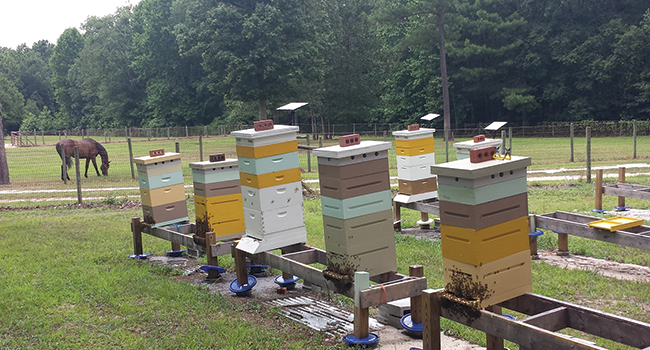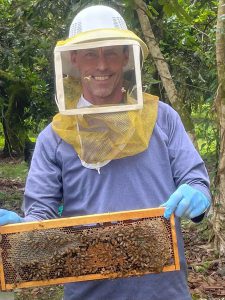By: Darryl Gabritsch
The balancing act of managing the needs of honey bees while managing the needs of horses is challenging.
It’s difficult to find an article addressing the coexistence needs of both. Honey bees need suitable locations to live, water and nectar and pollen producing food sources. Horses need suitable locations to live, water for drinking, and food source areas free of toxic plants. The challenge for the beekeeper is how to provide support for the needs of the honey bees without harming the horses and still meeting the horse’s needs.
The first challenge is a good location to live. Horses need large fields with lots of sun with patches of shade, ample room to run, a water source and, in a perfect world, some sort of overhead shelter. Honey bees need to have their hives facing South, an area that is preferably in full sun. The hive also needs to be relatively near water and not in low areas where night temperatures drop too low. Hives should not be located in the horse paddocks since horses are naturally curious and might knock over hives.
One scenario is that a horse knocks over the hive, the honey bees become defensive and sting the horse. The honey bees are at a loss until a beekeeper puts hive back in order. The horse is at a loss because it gets stung, and possibly gets more severely injured by slipping and injuring a leg, possibly running into a fence and getting a laceration, etc (let your “what if” imagination run wild) as the horse runs away from the threat. Calling a veterinarian out to suture a laceration is an expensive lesson that’s best not learned the hard way. A farm call for a veterinarian to suture a minor laceration could cost well over $200 in initial costs plus follow-up visit costs if needed.
The second challenge is balancing water needs of the honey bees and the horses. The honey bees need water to dilute honey and to cool the hive during hot weather. The horse needs gallons of water to survive. If the hive is too close to horse troughs the bees can intimidate the horse as numerous honey bees fly around the watering troughs as they forage for water.
I recently observed this firsthand when my wife, a veterinarian, came inside our house and told me that I needed to “do something with the honey bees”. I went out to investigate the problem, and sure enough there were more than two dozen honey bees buzzing on and around the water trough as the horse repeatedly tried to get water. There stood the poor horse desperately trying to get to the water while swatting at the honey bees with its tail as the bees buzzed the horse. Honey bees might fly as far as six miles to get water, but they prefer closer distances. In a perfect world the apiary would be located within 300 feet of a natural water source such as a pond or creek that is located outside of a horse paddock and located between the horse paddock and the hive since honey bees make an average of 50 to 100 trips a day for water during hot weather. Most people don’t live in the perfect world. Things you could try to help solve the water challenge:
- Put a smaller water trough near the bees. You can make it more inviting by adding a capful of bleach to scent the water as long as the trough is fairly large, and by adding floats to the water such as yellow dog bone sponges or a PVC pipe float with window screen zip tied to it. The bleach scent, as well as the sponges and /or PVC float, makes it easier for the honey bees to find the water trough as they forage for water. I usually add several sponges to the top of the window screen covered float. The PVC float and window screen will keep the sponges from getting saturated and sinking to the bottom of the trough. You should change out the water in the troughs about once a week to keep mosquitoes out. You will also need to scrub the tubs (brush only, no soap) and rinse sponges to keep algae to a minimum.
- Put a division board feeder with a cap and ladder system filled with water inside the hive.
- Put a slatted rack on the hive. The slatted rack is normally used with solid bottom boards, but can be used with screened bottom boards. It normally isn’t needed if you are using a screened bottom board with the Integrated Pest Management sticky board removed. The slatted rack fits between the bottom board and the bottom brood chamber hive body. The slatted rack has the same outside measurements as the hive bodies above it. The rack is normally about two inches deep, with a solid piece of wood horizontally across the front of the rack and parallel slats at the back of the rack that align with the brood frames in the brood chamber above it. The slatted rack provides an air space between the bottom board and the brood chamber which helps keep the bees cooler in the Summer.
- Active ventilation measure: Install a solar powered ventilation system on top of the hive. This is an expensive endeavor, but may be necessary if you want to keep both horses and honey bees in close proximity to each other. A solar powered ventilation system replaces an inner cover. The ventilation system goes under the telescoping top cover. Solar powered ventilators use a solar panel to power a small DC powered fan, have a screen under the fan to prevent honey bees from touching the fan, and have vents normally facing the front of the hive. Typical costs can be around $130 or more for each solar powered ventilator system.
- Passive ventilation measure: Install a screened ventilation shim in place of an inner cover. There are numerous plans on the internet on how to construct them. They are simply a frame (converted honey super, 1”x4” boards or similar size boards) with holes drilled on all sides with screen stapled to the inside of the frame covering the holes. Some versions even put screens horizontally on the top and bottom to serve as a screen barrier to keep honey bees from coming out of the hive as you pour sugar syrup through the top of the ventilation shim into hive top feeders if the ventilation shim is placed on top of a hive top feeder. Passive ventilation shims aren’t as effective as the active solar powered ventilation systems, but they are a cheap option for the budget conscious beekeeper. Typical costs can be around $10 or less for each ventilation shim if you make it yourself.
- Temporarily put shade over the hives. Construct a removable shed type covering that could be placed over the hive that provides air space between the shed and hive while leaving room for the bees to fly into and out of the front of the hive.
The third challenge is balancing food needs of the honey bee while avoiding plants that are toxic to horses. There are many great nectar and pollen producing plants available to the beekeeper, but you must do extensive research to ensure the plant isn’t toxic to the horses. I read several books and articles on good nectar producing plants and selected the black locust tree, Robinia pseudoacacia and Wild cherry tree, Prunus serotina. My wife quickly pointed out that they are both toxic to horses. She then handed a copy of her toxic plants bulletin to me and told me to do some research before I ordered any plants. Lesson learned: What’s good for the honey bees might not be good for any nearby animals. You can research plant toxicity to animals from numerous sources. You should cross reference multiple research sources for information since a single source may not list your particular plant; whereas another source might have it listed as being toxic. You need to closely verify both the common name and the scientific name of the selected plant to ensure the plant you are researching is correct. For example if you search Lily of the valley (common name) without cross referencing the scientific name you would find that Lily of the valley, Pieris japonica (a four to eight foot tall bush) is toxic; whereas Lily of the valley (also known as Sourwood), Oxydendrum arboreum (a 20-30 foot tall tree) is not toxic and produces a nectar that honey bees convert into a sought after honey. The starting point locations to research toxicity that this author used are:
https://plants.ces.ncsu.edu/plants/category/poisonous-plants/
https://www.aspca.org/pet-care/animal-poison-control/toxic-and-non-toxic-plants
https://www.accessdata.fda.gov/scripts/plantox/detail.cfm?id=4677
Plants Poisonous to Livestock and Pets in North Carolina, Revised Edition (North Carolina Agricultural Research Service Bulletin, No. 414) Paperback – 1994 by James W. Hardin (Author), Cecil F. Brownie (Author). ASIN: B007FCS6HU. The book is a bulletin produced by the NC Agricultural Research Service, North Carolina State University, Raleigh, NC.
In the end I decided to order several Tulip Poplar, Liriodendron tulipifera trees and Sourwood, Oxydendrum arboreum trees to plant near my honey bees. The bees will get a good nectar source and the horses will get a natural shade source. You CAN have happy, healthy honey bees and horses coexisting in close proximity if you simply do a little planning and research.
Darryl Gabritsch lives and keeps bees in North Carolina with his family.









